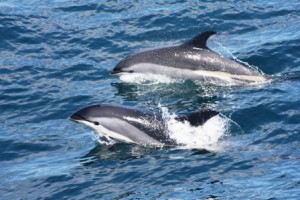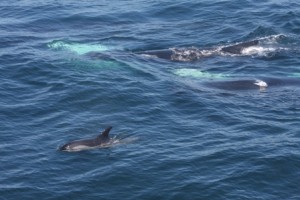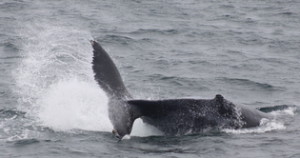Dolphin Fleet Naturalist Notebook – 17 July to 23 July
On July 17th our naturalist, Gwen, writes, “We begin in the northeast of the triangle with 12-15 minkes. Great looks at them! My best minke sightings of the year. We also picked up four humpback whales — a cow/calf pair with two adults. The calf stayed near the boat while the other three kept diving. We also had 1-2 fin whales. We then headed southeast and encountered a single humpback feeding deep. We passed another one at the race, also deep diving.
“The afternoon started with a stiff breeze from the southwest at 15 knots. A great boat with lots of inquisitive folks! We traveled to the northeast of the triangle again and were greeted by Cajun and calf, Pele, and Milkweed. Their behavior was exactly the same as when we left them this afternoon. This time around the calf was more animated though – breaching, flipper slapping, blowing bubbles below the surface and then joining the other three when they came back up. We had one more adult nearby. Headed southweast homebound and crossed path with one humpback tail lobbing. Cap it off with a perfect sunset. Great trip!”
On July 18th, we headed back to Stellwagen Bank to find three different species of whale: humpbacks, Minkes, as well as one fin whale. While the humpback whales tend to steal the show with their acrobatic behavior and fluking dives, it can be just as exciting to catch a glimpse of the sleek, fast-moving fin whale, which is the second largest animal on the planet!
The whales weren’t the only thing catching our eye on this trip. Everywhere we looked, we could see frothy white water where enormous bluefin tuna were breaking the surface. Bluefin tuna are marvels of evolution, equipped to cross the Atlantic multiple times per year and regulate their temperatures to survive in frigid waters. These animals are also rapidly declining in numbers globally.
An exciting top-off to an otherwise excellent day of whale watching was our sighting of an enormous basking shark. Unlike the great whites that have been in the news of late, these enormous creatures have no functional teeth, and instead resemble the right whale in their feeding style, as they open their mouths and swim forward to trap tiny crustaceans in their gill-rakers. The basking shark is the second largest fish on the planet, and can reach lengths of up to 30 feet! Basking sharks are named because they are often observed at the surface, “basking” in the sun, but recent studies have shown that these sharks can spend their winter months lurking in deep trenches after migrating hundreds of miles south.
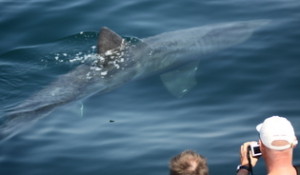

We were excited to see new humpbacks enter the Stellwagen Bank area today. One new sightings for the year was a whale named Fern. Fern is a female, who has had calves in previous years, but this year she was joined by two adults named Eruption and Gunslinger. We found Fern and the group easily because Fern was rolling on her side, slapping her flipper on the water. We don’t exactly know why these humpbacks do this, but it seems to be associated with the formation or dissolution of social groups.
On July 21st we were excited to have one of our favorite humpbacks on Stellwagen Bank: an old female named Salt. Salt is the favorite whale of the Dolphin Fleet, as she was the first humpback in this area to officially get a name. She was named by a Dolphin Fleet whale watching captain because it looks like someone had sprinkled Salt all over her dorsal fin. Since 1975, we have seen Salt almost every year, many times with a calf by her side. This year, she is here with her 12th known calf. Her calf has been named Zelle. Most of the time, calves don’t receive a name until they have returned for a second feeding season on their own, but Salt’s calves are special cases. They get names with a “salty” theme. Zelle is a type of high-quality white salt mined from peat.
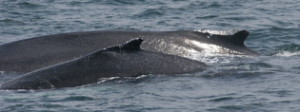
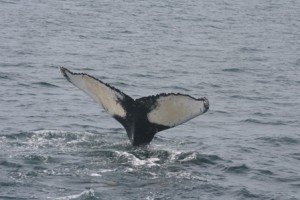
By July 23rd, most of the dolphins had left the area, and more humpbacks had joined Cajun and the calf. Scratch, a female, and Belly, a young humpback of unknown sex, fluked and surfaced alongside Cajun, Alphorn, Pele, and Milkweed.


Cajun’s calf, active as ever, spent much of this gray day rolling and playing at the surface while the adults dove. Cajun’s calf is large and appears healthy. In the coming weeks, expect her to start learning how to feed on solid food as she weans from her mothers milk.








